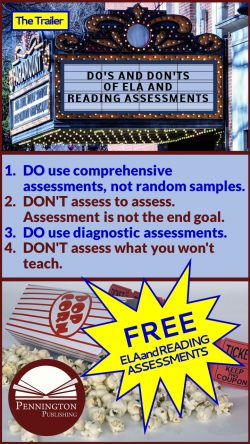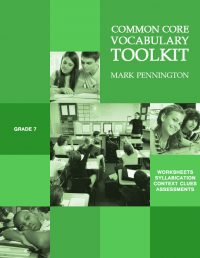Don’t Assess What You Won’t Teach
Many movie theaters are now opting to sell you specific seats for a show time, rather than the traditional first come first served model. Although you have to pay a premium for this advanced purchase option, I think it’s worth every penny. Here’s why: If you time it right, you can show up to your assigned seat right before the start of the movie and skip the annoying previews (usually known as trailers for some reason). According to an editor on Reddit, these trailers (including commercials and warnings to “Please silence your cell phone”) average 15-20 minutes.
In my Do’s and Don’ts of ELA and Reading Assessments series, I began with a trailer to introduce the articles. This preview, Do use comprehensive assessments, not random samples, focused on why teachers want quick, whole-class, comprehensive assessments which produce the specific data regarding what students know and what they don’t know about a subject and why normed tests and achievement tests, such as the PAARC, SWBAC, and other state CCSS tests don’t provide that data. As an enticement to read the articles (and check out my Pennington Publishing programs to teach to the assessments) I provided two assessments which meet that desired criteria: the 1. Alphabetic Awareness Assessment and the 2. Sight Syllables (Greek and Latin prefix and suffix) Assessment. Additionally, the respective downloads include the answers, corresponding matrices, administrative audio files, and ready-to-teach lessons.
But first, let’s take a look at the first three-part episode in the Do’s and Don’t of ELA and Reading Assessments series: DON’T assess to assess. Assessment is not the end goal. DO use diagnostic assessments. DON’T assess what you won’t teach. Plus, wait ’til you see the FREE download at the end of this article! Plus, a bonus.
DON’T assess to assess. Assessment is not the end goal.
A number of years ago, our seventh and eighth-grade ELA department gathered over a number of days in the summer to plan a diagnostic assessment and curricular map to teach the CCSS grammar, usage, and mechanics standards L. 1, 2, and 3. I was especially pleased with the diagnostic assessment, which covered K-6 standards and felt that the team was finally ready to help students catch up while they keep up with grade-level standards.
By the end of the first two weeks of instruction, every ELA teacher had dutifully administered, corrected, and recorded the results of the assessment on our progress monitoring matrix. I began developing worksheets to target the diagnostic deficits and formative assessments to determine whether students had mastered these skills and concepts. I placed copies of the worksheets in our “share binder.” My students were excited to see their progress in mastering their deficits while we concurrently worked on grade-level instruction.
At our monthly team meeting, I brought my progress monitoring matrix to brag on my students. “That’s great, Mark.” “Nice work. I don’t know how you do it.” No one else had done anything with the diagnostic data.
Somehow I got up enough courage to ask, “Why did you all administer, correct, and record the diagnostic assessment if you don’t plan on using the data to inform your instruction?”
Responses included, “The principal wants us to give diagnostic assessments.” “The test did give me a feel for what my class did and did not know.” “It shows the students that they don’t know everything.” “It confirms my belief that previous teachers have not done a good job teaching, so I have to teach everything.”
Class time is too valuable to waste. Assessment is not an end in and of itself.
DO use diagnostic assessments.
Let’s face it; we all bring biases into the classroom. We assume that Student A is a fluent reader because she is in an honors class. Of course, Student B must be brilliant just like her older brother. Student C is a teacher’s kid, so she’ll be a solid writer. My assumptions have failed me countless times as I’m sure have yours.
Another piece of baggage teachers carry is generalization. We teach individuals who are in classes. “We all talk about a class as if it’s one organism. “That class is a behavioral nightmare.” “That class is so mean to each other.” “It takes me twice as long to teach anything to that class.” “This class had Ms. McGuire last year. She’s our staff Grammar Nazi, so at least the kids will know their parts of speech.” We lump together individuals when we deal with groups. It’s an occupational hazard.
To learn what students know and don’t know, so that we can teach both the class and individual, we have to remove ourselves as variables to eliminate bias and generalizations. Diagnostic assessments do the trick. Wait ’til you download the FREE diagnostic assessment at the end of this article; it transformed my teaching and has been downloaded thousands of times over the years by teachers to inform their instruction.
Additionally, diagnostic assessments force us to teach efficiently. When we learn that half the class has mastered adverbs and half has not, we are forced to figure out how to avoid re-teaching what some students already know (wasting their time) while helping the kids who need to learn. As an aside, many teachers avoid diagnostic assessments because the results require differentiated or individualized instruction. Naivete is bliss. Diagnostic assessments are amazing guilt-producers.
Be an objective teacher, willing to let diagnostic data guide your instruction. Teaching is an art, but it is also a science.
DON’T assess what you won’t teach.
Many teachers begin the school year with a battery of diagnostic assessments. The results look great on paper and do impress administrators and colleagues; however, the only data that is really impressive is the data that you will specifically use to drive instruction. Gathering baseline data is a waste of time if you won’t teach to that data.
I suggest taking a hard look at the diagnostic assessments you gave last year. If you didn’t use the data, don’t do the assessment. Now, this doesn’t mean that you can’t layer on that diagnostic assessment in the spring if you are willing (and have time) to teach to the data. Diagnosis is not restricted to the fall. Teachers begin the school year with high expectations. Don’t bite off more than you can chew at once.
Additionally, more and more teachers are looking critically about the American tradition of unit-ending tests. Specifically, teachers are using unit tests as formative assessments to guide their re-teaching. Rather than a personal pat on the back (if students scored at an 85% average) or a woe-is-me-I’m-a-horrible-teacher-or-my-students-are-just-so-dumb-or-the-test-was-just-too-hard response (if students scored at a 58% average), unit tests can serve an instructional purpose.
Now I know that teachers will be thinking, “We have to cover all these standards; we don’t have time to re-teach.” I’ll address this concern with a simplistic question that more than once has re-prioritized my own teaching. It really is an either-or question: Is teaching or learning more important?
For those who answer, learning, don’t add to your admirable burden by assessing what you won’t teach.
That’s it for now. The credits are rolling, but keep reading because the end of the credits may have a few surprises. Purchase your ticket for the next installment of ELA and Reading Assessments Do’s and Don’ts: Episode 2 and get more 15 FREE ELA and reading assessments, corresponding recording matrices, administrative audio files, and ready-to-teach lessons. A 92% score on Rotten Tomatoes! Here’s the preview: DO analyze data with others (drop your defenses). DON’T assess what you can’t teach. DO steal from others. DON’T assess what you must confess (data is dangerous). Check it out HERE!
*****
The Science of Reading Intervention Program
The Science of Reading Intervention Program: Word Recognition includes explicit, scripted instruction and practice with the 5 Daily Google Slide Activities every reading intervention student needs: 1. Phonemic Awareness and Morphology 2. Blending, Segmenting, and Spelling 3. Sounds and Spellings (including handwriting) 4. Heart Words Practice 5. Sam and Friends Phonics Books (decodables). Plus, digital and printable sound wall cards and speech articulation songs. Print versions are available for all activities. First Half of the Year Program (55 minutes-per-day, 18 weeks)
The Science of Reading Intervention Program: Language Comprehension resources are designed for students who have completed the word recognition program or have demonstrated basic mastery of the alphabetic code and can read with some degree of fluency. The program features the 5 Weekly Language Comprehension Activities: 1. Background Knowledge Mentor Texts 2. Academic Language, Greek and Latin Morphology, Figures of Speech, Connotations, Multiple Meaning Words 3. Syntax in Reading 4. Reading Comprehension Strategies 5. Literacy Knowledge (Narrative and Expository). Second Half of the Year Program (30 minutes-per-day, 18 weeks)
The Science of Reading Intervention Program: Assessment-based Instruction provides diagnostically-based “second chance” instructional resources. The program includes 13 comprehensive assessments and matching instructional resources to fill in the yet-to-be-mastered gaps in phonemic awareness, alphabetic awareness, phonics, fluency (with YouTube modeled readings), Heart Words and Phonics Games, spelling patterns, grammar, usage, and mechanics, syllabication and morphology, executive function shills. Second Half of the Year Program (25 minutes-per-day, 18 weeks)
The Science of Reading Intervention Program BUNDLE includes all 3 program components for the comprehensive, state-of-the-art (and science) grades 4-adult full-year program. Scripted, easy-to-teach, no prep, no need for time-consuming (albeit valuable) LETRS training or O-G certification… Learn as you teach and get results NOW for your students. Print to speech with plenty of speech to print instructional components.
Get the Diagnostic Grammar and Usage Assessment with Recording Matrix FREE Resource:
![]()
Get the Grammar and Mechanics Grades 4-8 Instructional Scope and Sequence FREE Resource:
![]()
Grammar/Mechanics, Literacy Centers, Reading, Spelling/Vocabulary









